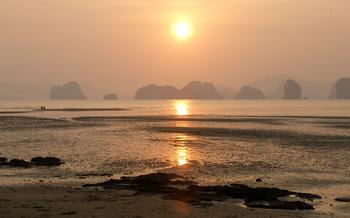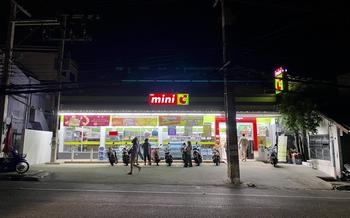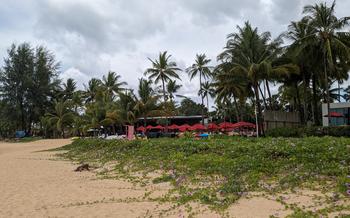
Ban Nam Khem Tsunami Memorial Park
- History of the Ban Nam Khem Tsunami Memorial Park:
- Architecture and Design
- Exhibitions and Displays
- Memorial Wall and Garden
- Prayer and Meditation Areas
- Educational Programs
- Local Community Involvement
- Respect and Etiquette
- Volunteer Opportunities
- Nearby Attractions: Exploring Beyond the Memorial
- Accessibility for Persons with Disabilities
- Photography and Videography
- An Insider's Perspective
History of the Ban Nam Khem Tsunami Memorial Park:
The devastating Indian Ocean tsunami of 2004 left an indelible mark on the coastal communities of Thailand, including the village of Ban Nam Khem in Phang Nga province. The tsunami, triggered by a massive undersea earthquake, struck on December 26, 2004, with colossal waves that swept away entire villages and claimed countless lives. Ban Nam Khem, which was directly in the path of the tsunami, suffered catastrophic damage, with hundreds of residents losing their lives and many more displaced.
In the aftermath of the tragedy, the Ban Nam Khem Tsunami Memorial Park was established as a place of remembrance and reflection for the victims and their families. The park serves as a poignant tribute to those who perished and a symbol of the resilience and strength of the community in the face of adversity. It stands as a reminder of the devastating impact of the tsunami and the importance of disaster preparedness and community unity.
Architecture and Design
The Ban Nam Khem Tsunami Memorial Park stands as a testament to resilience and remembrance through its unique architectural features. The wave-shaped structures, a recurring motif throughout the park, symbolize the devastating force of the tsunami that struck the region. These structures, reminiscent of the waves that once brought destruction, now serve as a reminder of the strength and unity of the community in the face of adversity.
The integration of local culture and traditions into the park's architecture adds a layer of significance and authenticity. Traditional Thai elements, such as intricate carvings and vibrant colors, blend seamlessly with modern design, creating a harmonious balance between past and present. The result is a space that not only commemorates the tragedy but also celebrates the resilience and spirit of the Thai people.
The park's design encourages visitors to engage with their surroundings, promoting reflection and introspection. Pathways meander through the park, leading visitors on a journey of remembrance and healing. Carefully placed benches offer moments of respite, inviting visitors to pause and contemplate the events of the past and the hope for the future.
Exhibitions and Displays
The Ban Nam Khem Tsunami Memorial Park features a range of exhibitions and displays that provide visitors with a comprehensive understanding of the events of the 2004 Indian Ocean tsunami and its impact on the local community. These exhibits employ various mediums to convey the experiences of survivors, the devastation caused by the disaster, and the subsequent recovery efforts. Through multimedia presentations, artifacts, and personal stories, visitors gain a deeper insight into the human toll of the tragedy and the resilience of the Ban Nam Khem community. The exhibitions serve as a powerful reminder of the importance of disaster preparedness, community unity, and the enduring legacy of the tsunami.
Memorial Wall and Garden
At the heart of the Ban Nam Khem Tsunami Memorial Park lies a poignant memorial wall, a lasting tribute to those who lost their lives in the devastating tsunami. The wall, constructed from local materials, stands as a solemn reminder of the tragedy and bears the names of the victims, etched in stone to honor their memory. Each name carries a story, a life cut short by the relentless force of nature.
Beside the memorial wall is a serene memorial garden, a sanctuary for reflection and remembrance. Lush greenery, vibrant flowers, and tranquil water features create a calming atmosphere, inviting visitors to pause and contemplate the lives lost and the resilience of the community. The garden serves as a sacred space for families and friends to grieve, seek solace, and find comfort in the midst of their loss.
Prayer and Meditation Areas
Within the serene confines of the Ban Nam Khem Tsunami Memorial Park, designated areas have been thoughtfully created to facilitate prayer and meditation. These spaces offer visitors solace and an opportunity to connect with their spirituality, seeking comfort and understanding amidst the remembrance of the tragedy.
Respecting the diverse cultural and religious traditions of those affected by the tsunami, the memorial park incorporates prayer and meditation areas that cater to various beliefs. Whether it's a quiet corner for personal reflection, a designated space for group prayers, or a tranquil spot for mindful meditation, visitors are welcome to find solace and seek inner peace within these sacred spaces.
The prayer areas, often adorned with symbolic motifs or religious iconography, provide a sanctuary for visitors to offer their prayers and supplications. The meditation areas, with their calming ambiance and serene surroundings, invite visitors to sit in quiet contemplation, fostering a connection with their inner selves and finding solace in the midst of remembrance.
Educational Programs
The Ban Nam Khem Tsunami Memorial Park serves as a vital educational platform, offering a range of programs aimed at raising awareness about tsunamis, disaster preparedness, and community resilience. Through guided tours, workshops, and interactive activities, visitors gain insights into the events of the 2004 Indian Ocean tsunami, its devastating impact on local communities, and the remarkable efforts undertaken for recovery and rebuilding. These educational initiatives emphasize the importance of disaster risk reduction, promoting a culture of preparedness and resilience among visitors and the wider community. By fostering a deeper understanding of tsunamis and their potential consequences, the park contributes to building a safer and more resilient society.
Local Community Involvement
The Ban Nam Khem Tsunami Memorial Park stands as a testament to the resilience and unity of the local community in the face of tragedy. Survivors, volunteers, and community organizations played a crucial role in the establishment and ongoing maintenance of the park. Their unwavering commitment to preserving the memory of the victims and promoting healing within the community is evident in every aspect of the park's operation.
Local residents actively participated in the design and construction of the memorial, ensuring that it reflected the cultural and historical significance of the area. They shared their personal stories and experiences, contributing to the creation of a space that authentically captures the impact of the tsunami on their lives.
The community's involvement extends beyond the physical construction of the park. They regularly organize events, workshops, and educational programs to raise awareness about the importance of disaster preparedness, community resilience, and the preservation of local culture. These initiatives not only foster a sense of unity and healing within the community but also provide a platform for sharing valuable lessons learned from the tragedy.
The Ban Nam Khem Tsunami Memorial Park stands as a symbol of the strength and resilience of the local community. Their dedication to preserving the memory of the victims and promoting healing serves as an inspiration to visitors from around the world.
Respect and Etiquette
The Ban Nam Khem Tsunami Memorial Park is a sacred and solemn place dedicated to the memory of those who lost their lives in the devastating tsunami. Visitors are expected to show respect and observe proper etiquette while visiting the park. Refrain from loud talking, boisterous behavior, or activities that may disturb the peace and tranquility of the memorial. Dress modestly and appropriately, avoiding revealing or disrespectful clothing. It is also essential to be mindful of the feelings of survivors, their families, and the local community. Refrain from intrusive questions or insensitive remarks that may cause discomfort or distress. Instead, approach interactions with empathy and compassion. Remember that the park is a place for reflection, remembrance, and healing, and visitors should strive to create a respectful and supportive environment for all.
Volunteer Opportunities
The Ban Nam Khem Tsunami Memorial Park welcomes volunteers who are passionate about contributing to its mission of remembrance, education, and community healing. Volunteering at the park offers a unique opportunity to make a positive impact and connect with the local community.
Visitors interested in volunteering can contact the park's administration to inquire about current opportunities. Roles may include assisting with park maintenance, educational programs, or community outreach initiatives. Volunteers can also contribute their skills and expertise in areas such as research, event planning, or fundraising.
By volunteering at the Ban Nam Khem Tsunami Memorial Park, visitors can not only support the park's important work but also gain valuable insights into the history, culture, and resilience of the local community. It is a rewarding and fulfilling experience that allows volunteers to make a meaningful difference while honoring the memory of those affected by the tsunami.
Nearby Attractions: Exploring Beyond the Memorial
Surrounding the Ban Nam Khem Tsunami Memorial Park, visitors can embark on a journey to discover a kaleidoscope of captivating attractions that offer a harmonious blend of natural wonders, historical landmarks, and cultural experiences. A short drive from the park, the stunning Phang Nga Bay beckons with its majestic limestone karsts rising out of the turquoise waters, creating a breathtaking panorama. Embark on a boat tour to witness the iconic James Bond Island, immortalized in the eponymous film, and explore hidden caves and secret lagoons that reveal the bay's untamed beauty.
For those fascinated by history and culture, a visit to the Phang Nga National Museum is a must. The museum houses an impressive collection of artifacts, historical documents, and interactive exhibits that narrate the rich history and cultural heritage of the region. Delve into the tales of ancient civilizations, explore the origins of local traditions, and gain a deeper understanding of the diverse ethnic groups that have shaped Phang Nga's unique identity.
To experience the vibrant local culture, head to the lively Phang Nga Town, where bustling markets, colorful temples, and traditional Thai cuisine await. Stroll through the vibrant streets, immerse yourself in the sights, sounds, and aromas of the town, and indulge in delicious local delicacies that capture the essence of Thai culinary heritage.
For nature enthusiasts, the Khao Lak-Lam Ru National Park offers a sanctuary of pristine beaches, lush rainforests, and diverse wildlife. Embark on a thrilling jungle trek, spot exotic birds and animals in their natural habitat, and unwind on secluded beaches, where the only sounds are the gentle lapping of waves and the whisper of the wind through the trees.
Combining a visit to the Ban Nam Khem Tsunami Memorial Park with these nearby attractions creates a well-rounded itinerary that caters to diverse interests and provides a holistic experience of Phang Nga's natural, historical, and cultural treasures.
Accessibility for Persons with Disabilities
The Ban Nam Khem Tsunami Memorial Park is committed to ensuring accessibility for all visitors, including those with disabilities. Wheelchair ramps and accessible pathways are available throughout the park, making it easy for visitors to navigate the grounds. Designated parking areas are also provided for visitors with disabilities, ensuring convenient access to the memorial.
-
Wheelchair ramps: The park features wheelchair ramps at all entrances and exits, allowing visitors with disabilities to enter and exit the park without difficulty.
-
Accessible pathways: The pathways throughout the park are wide and well-maintained, making it easy for visitors with disabilities to navigate the grounds.
-
Designated parking areas: There are designated parking areas located near the entrance of the park, reserved for visitors with disabilities. These parking spaces are wider than standard spaces and are located close to the park's entrance for easy access.
Photography and Videography
Respectful Capturing of Memories
Photography and videography are permitted within the Ban Nam Khem Tsunami Memorial Park, allowing visitors to capture their experiences and share them with others. However, it is essential to exercise caution and respect while doing so. Visitors should avoid taking photographs or videos that may intrude on the privacy of other visitors or detract from the solemn atmosphere of the memorial. It is also important to be mindful of the cultural and religious sensitivities of the local community and to avoid capturing images that may be considered disrespectful.
When taking photographs or videos, visitors should focus on capturing the beauty and significance of the memorial park, the stories of resilience and remembrance, and the importance of disaster preparedness. It is recommended to use a telephoto lens to maintain a respectful distance from subjects and to avoid using flash photography, which can be disruptive to other visitors.
By following these guidelines, visitors can ensure that their photography and videography contribute to the preservation of the memory of the tsunami and the promotion of understanding and compassion.
An Insider's Perspective
One of the most poignant aspects of the Ban Nam Khem Tsunami Memorial Park is the collection of personal belongings found in the aftermath of the disaster. These items, which include clothing, toys, and photographs, offer a glimpse into the lives of those who were lost. While it can be difficult to view these artifacts, they serve as a powerful reminder of the tragedy and the importance of remembrance.
For a truly immersive experience, consider visiting the park during the annual tsunami memorial ceremony, held on December 26th. This solemn event brings together survivors, families of the deceased, and community members to pay tribute to the victims and honor their memory. The ceremony includes prayers, candle lighting, and the release of doves, creating a deeply moving and emotional experience.



